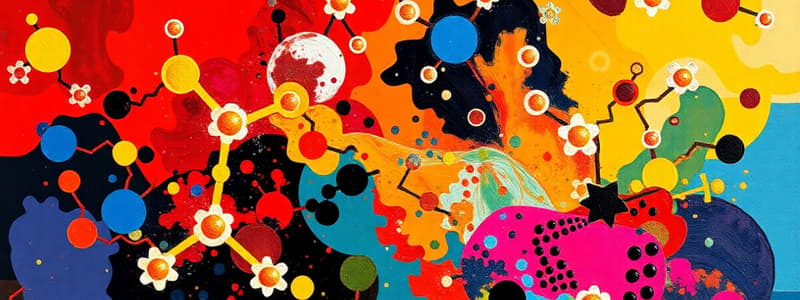Podcast
Questions and Answers
What is the precursor molecule from which D-glucuronic acid is derived?
What is the precursor molecule from which D-glucuronic acid is derived?
- Glucose (correct)
- Mannose
- Galactose
- Fructose
What results in the formation of aldaric acids?
What results in the formation of aldaric acids?
- Oxidation of only the carbonyl carbon
- Oxidation of both the carbonyl carbon and the last hydroxyl carbon (correct)
- Oxidation of the carbonyl carbon and the first hydroxyl carbon
- Reduction of both the carbonyl carbon and the last hydroxyl carbon
Which type of acid is produced by the oxidation described in the content?
Which type of acid is produced by the oxidation described in the content?
- Lactic acids
- Monocarboxylic acids
- Dicarboxylic acids (correct)
- Tricarboxylic acids
Which of the following best describes D-glucuronic acid?
Which of the following best describes D-glucuronic acid?
Among the following, which is characteristic of aldaric acids?
Among the following, which is characteristic of aldaric acids?
In the context of sugar acids, how is D-glucuronic acid categorized?
In the context of sugar acids, how is D-glucuronic acid categorized?
Which chemical feature distinguishes D-glucuronic acid from glucose?
Which chemical feature distinguishes D-glucuronic acid from glucose?
What distinguishes aldaric acids from other acids?
What distinguishes aldaric acids from other acids?
Which of the following statements is true concerning the oxidation of carbon atoms in the formation of aldaric acids?
Which of the following statements is true concerning the oxidation of carbon atoms in the formation of aldaric acids?
What is the significance of D-glucuronic acid in biological systems?
What is the significance of D-glucuronic acid in biological systems?
What type of reaction is involved in the formation of aldonic acid?
What type of reaction is involved in the formation of aldonic acid?
What is true about the essential vitamin mentioned?
What is true about the essential vitamin mentioned?
Why is the vitamin classified as essential?
Why is the vitamin classified as essential?
What is the primary functional group conversion that occurs when an aldehyde is oxidized to form an aldonic acid?
What is the primary functional group conversion that occurs when an aldehyde is oxidized to form an aldonic acid?
Which statement is incorrect regarding the essential vitamin?
Which statement is incorrect regarding the essential vitamin?
Which of the following best describes aldonic acids?
Which of the following best describes aldonic acids?
What is a consequence of not consuming the essential vitamin?
What is a consequence of not consuming the essential vitamin?
In the context of carbohydrate chemistry, what characterizes an aldonic acid?
In the context of carbohydrate chemistry, what characterizes an aldonic acid?
Which of the following statements about aldonic acids is false?
Which of the following statements about aldonic acids is false?
What distinguishes an essential vitamin from non-essential nutrients?
What distinguishes an essential vitamin from non-essential nutrients?
What are the classic symptoms of hyperglycemia associated with diabetes?
What are the classic symptoms of hyperglycemia associated with diabetes?
Which of the following symptoms is NOT commonly associated with hyperglycemia?
Which of the following symptoms is NOT commonly associated with hyperglycemia?
In what type of body tissues are carbohydrates predominantly found?
In what type of body tissues are carbohydrates predominantly found?
Which of the following best describes polyphagia in the context of hyperglycemia?
Which of the following best describes polyphagia in the context of hyperglycemia?
What do the symptoms of polydipsia, polyuria, and polyphagia indicate in a clinical context?
What do the symptoms of polydipsia, polyuria, and polyphagia indicate in a clinical context?
What is a common symptom of lactose intolerance?
What is a common symptom of lactose intolerance?
Which symptom is most indicative of lactose intolerance?
Which symptom is most indicative of lactose intolerance?
What is another gastrointestinal symptom that may accompany lactose intolerance?
What is another gastrointestinal symptom that may accompany lactose intolerance?
Which factor is most likely to lead to symptoms associated with lactose intolerance?
Which factor is most likely to lead to symptoms associated with lactose intolerance?
What could be a potential consequence of consuming dairy for those with lactose intolerance?
What could be a potential consequence of consuming dairy for those with lactose intolerance?
Flashcards
D-glucuronic acid
D-glucuronic acid
A sugar acid derived from glucose.
Sugar acids
Sugar acids
Organic compounds derived from sugars.
Glucose
Glucose
A simple sugar.
Level 1 - Semester 1
Level 1 - Semester 1
Signup and view all the flashcards
HBG
HBG
Signup and view all the flashcards
Aldonic acid formation
Aldonic acid formation
Signup and view all the flashcards
Oxidation of aldehyde group
Oxidation of aldehyde group
Signup and view all the flashcards
Aldonic acid
Aldonic acid
Signup and view all the flashcards
Carboxylic acid group
Carboxylic acid group
Signup and view all the flashcards
Dicarboxylic acids
Dicarboxylic acids
Signup and view all the flashcards
Oxidation
Oxidation
Signup and view all the flashcards
Carbonyl carbon
Carbonyl carbon
Signup and view all the flashcards
Hydroxyl carbon
Hydroxyl carbon
Signup and view all the flashcards
Lactose Intolerance
Lactose Intolerance
Signup and view all the flashcards
Symptoms of Lactose Intolerance
Symptoms of Lactose Intolerance
Signup and view all the flashcards
Dairy Products
Dairy Products
Signup and view all the flashcards
Abdominal Discomfort
Abdominal Discomfort
Signup and view all the flashcards
Diarrhea
Diarrhea
Signup and view all the flashcards
Hyperglycemia symptoms
Hyperglycemia symptoms
Signup and view all the flashcards
Diabetes
Diabetes
Signup and view all the flashcards
Polyuria
Polyuria
Signup and view all the flashcards
Polydipsia
Polydipsia
Signup and view all the flashcards
Polyphagia
Polyphagia
Signup and view all the flashcards
Essential Vitamin
Essential Vitamin
Signup and view all the flashcards
Dietary Intake
Dietary Intake
Signup and view all the flashcards
Human Synthesis
Human Synthesis
Signup and view all the flashcards
Vitamin Deficiency
Vitamin Deficiency
Signup and view all the flashcards
Essential Nutrient
Essential Nutrient
Signup and view all the flashcards
Study Notes
Course Information
- Course: HBG 102
- Level: 1
- Semester: 1
- Subject: Carbohydrates Chemistry
- Topic: Disaccharides & Sugar Derivatives
Sugar Derivatives
- Types and examples of each type are covered
- Structures of various sugar derivatives are illustrated
- Functions are described
Disaccharides
- Definitions, examples, and significance of disaccharides are explained
Learning Outcomes
- Students will be able to recognize sugar derivatives
- Students will be able to correlate the structure of sugar derivatives to their function
- Students will be able to apply their knowledge to clinical situations
- Students will be able to define and classify disaccharides
- Students will be able to recognize the significance of different types of disaccharides
Case Scenario (Clinical Correlate)
- Samir, a 50-year-old patient, presented with a 2-week history of polyuria (frequent urination), polydipsia (excessive thirst), polyphagia (excessive hunger), 20-pound weight loss, and blurred vision.
- A urinalysis indicated excess glucose.
- His initial blood glucose level was 340 mg/dL.
Learning Objectives (LOs)
- LO 1: Recognizing the monosaccharides derivatives
- LO 2: Correlating structure of various types of monosaccharides derivative to function
- LO 4: Correlation of knowledge to a clinical situation.
- LO 1: Defining and classifying disaccharides
- LO 2: Recognizing the structure of different types of disaccharides and their significance
Sugar Acids
- Definition: Oxidation products of monosaccharides
- Examples:
- Aldonic acids
- Uronic acids
- Aldaric acids
- L-ascorbic acid (Vitamin C)
Sugar Alcohols (Alditols)
- Definition: Products of reduction of monosaccharides
- Examples:
- D-glucitol (or D-sorbitol) from D-glucose
- D-mannitol from D-mannose
- D-sorbitol or D-mannitol from D-fructose
- D-galactitol or D-dulcitol from D-galactose
- D-ribitol from D-ribose
- D-xylitol from D-xylose
Deoxy-sugars
- Definition: Monosaccharides with one oxygen atom missing (one OH group replaced by H)
- Example: 2-deoxy-D-ribose is a constituent of DNA
Amino-Sugars
- Hydroxyl group replaced by an amino group at the C-2 position
- Examples: D-glucosamine, D-galactosamine
- Found in glycosaminoglycans and glycoproteins
Amino-sugar Acids
- Definition: Condensation products of amino sugars and some acids
- Example: Neuraminic acid (mannosamine + pyruvic acid) is found in neural tissues
Homodisaccharides
- Maltose: Formed from two α-D-glucose units linked by an α (1→4) glycosidic bond. Produced by the actions of amylase enzymes on starch. Hydrolyzed by maltase to produce 2 glucose molecules.
- Isomaltose: Formed from two α-D-glucose units linked by an α (1→6) glycosidic bond. A reducing sugar, obtained by hydrolysis of some polysaccharides, such as dextran.
- Cellobiose: Formed from two β-D-glucose units linked by a β (1→4) glycosidic bond. Obtained by acid hydrolysis of cellulose.
Heterodisaccharides
- Sucrose: Formed from α-glucose and β-fructose linked by an α(1→2) glycosidic bond. It is non-reducing. Hydrolysis catalyzed by sucrase.
- Lactose: Formed from β-galactose and β-glucose via a β (1→4) link with a free anomeric carbon. It is a reducing sugar. Found in milk; its hydrolysis is catalyzed by the enzyme lactase.
Clinical Correlates (Lactose Intolerance)
- Low levels of lactase lead to undigested lactose. Bacteria ferment this in the colon, generating CO2, H2, and organic acids.
- These products cause painful digestive upsets (lactose intolerance)
Case Scenario (Clinical Correlate - 2)
- Samira, a 65-year-old woman presenting with numbness in her toes and impaired vision.
- Blood Glucose level of 384 mg/dL.
Other
- Discussion and Feedback (10 minutes)
Studying That Suits You
Use AI to generate personalized quizzes and flashcards to suit your learning preferences.




